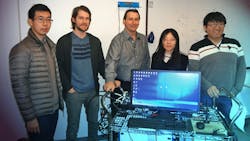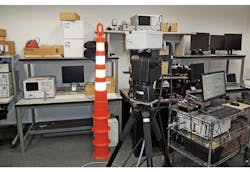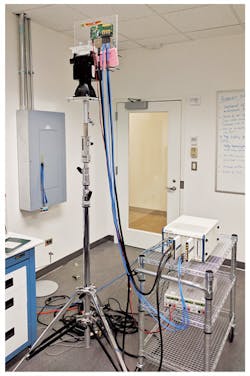NYU Wireless Drives Next-Generation Technology
This file type includes high resolution graphics and schematics when applicable.
The New York University (NYU) Wireless academic research center in Brooklyn, N.Y., is at the forefront of tomorrow’s wireless technology. Led by its founding director, Professor Ted Rappaport, NYU Wireless is focused on next-generation 5G wireless networks, with millimeter-wave technology being a major research area. NYU WIRELESS combines NYU’s Tandon School of Engineering, School of Medicine, and Courant Institute of Mathematical Sciences. Among its 16 industrial affiliates are Keysight Technologies and National Instruments (NI).
Although the center is known for its 5G research, a conversation with Rappaport during a recent visit to the NYU Wireless facility revealed that he is actually looking beyond that. He said his goal is to have leaders of “where the market will be.” Looking into the future, Rappaport said he believes that we will someday have true three-dimensional (3D) video. He explained how NYU Wireless is investigating frequencies above 100 GHz into the sub-terahertz region.
The visit included a tour of two of the facility’s labs. The first stop was the channel-sounding lab (Figs. 1 and 2). “We have brought our equipment to locations in both Brooklyn and Manhattan to do measurements in the urban environment,” said George MacCartney Jr., an engineering Ph.D. candidate. “We elevate the transmitter to a lamppost level, which is expected for millimeter-wave access points in the future.
“Conducting measurements in different environments and scenarios allows us to create an overall physical model,” he continues. “Other people can then use our model instead of having to go out into the field and conduct their own measurements. We rotate the antennas along the azimuth and elevation planes at many different angles in order to gain an omnidirectional sense of the environment.” Interestingly enough, the antennas can actually be positioned with a PlayStation 3 controller, which is remotely controlled via LabVIEW.
In terms of future goals, MacCartney Jr. added, “We are hoping that future measurement systems utilize phased arrays that can electronically steer the beams. This will allow very fast measurements to be performed.” Moreover, new students are examining frequencies above 100 GHz.
According to Rappaport, “Our equipment and our students—past and present—proved that millimeter waves would work. We went out to New York City and proved that you don’t need to have line-of-sight (LOS) for millimeter-waves—everyone thought you did. This was driven by our rotational mechanical systems.
“We take the knowledge of the radio channel and put it into software, which can be used by others,” he continued. “Over 5,000 people in engineering companies around the world are using the NYUSIM channel simulator, which is freely downloadable.”
The NYUSIM channel simulator, an open-source 5G channel model simulator, is a result of measurements along with 5G millimeter-wave channel models that have been developed from 2 to 73 GHz. NYUSIM can be used to generate spatial and temporal wideband channel impulse responses.
The next stop of the tour was the lab that is investigating phased arrays (Fig. 3). According to Aditya Dhananjay, a postdoctoral research fellow, as well as the co-founder and president of MilliLabs (www.millilabs.com), “One of the focal points of our research is tunable millimeter-wave communications. With millimeter-wave systems, highly directional antenna beams are needed to enable communication between a transmitter and a receiver.
“In the lab, steering the beam in different directions can be achieved by rotating mounted antennas,” he continued. “But in reality, that’s not how you steer beams because they need to be steered on the order of microseconds. Steering beams on the order of microseconds requires phased arrays. We are one of the only schools with access to a phased-array system in our lab. We work with equipment from NI and Keysight.
“We also have millimeter-wave systems for data links,” added Dhananjay. “This capability allows us to send real data between a transmitter and a receiver instead of just measuring wireless propagation. We have also developed techniques to do phase-noise correction. At higher frequencies, oscillators tend to behave far worse than oscillators at lower frequencies. The techniques we have developed help to overcome hardware imperfections. We are also building millimeter-wave emulators.”
To summarize, NYU Wireless is clearly in the driver’s seat when it comes to 5G and millimeter-wave research. We can expect to see many more developments in the days ahead. On that note, the next Brooklyn 5G Summit will take place April 19-21, 2017.
This file type includes high resolution graphics and schematics when applicable.





